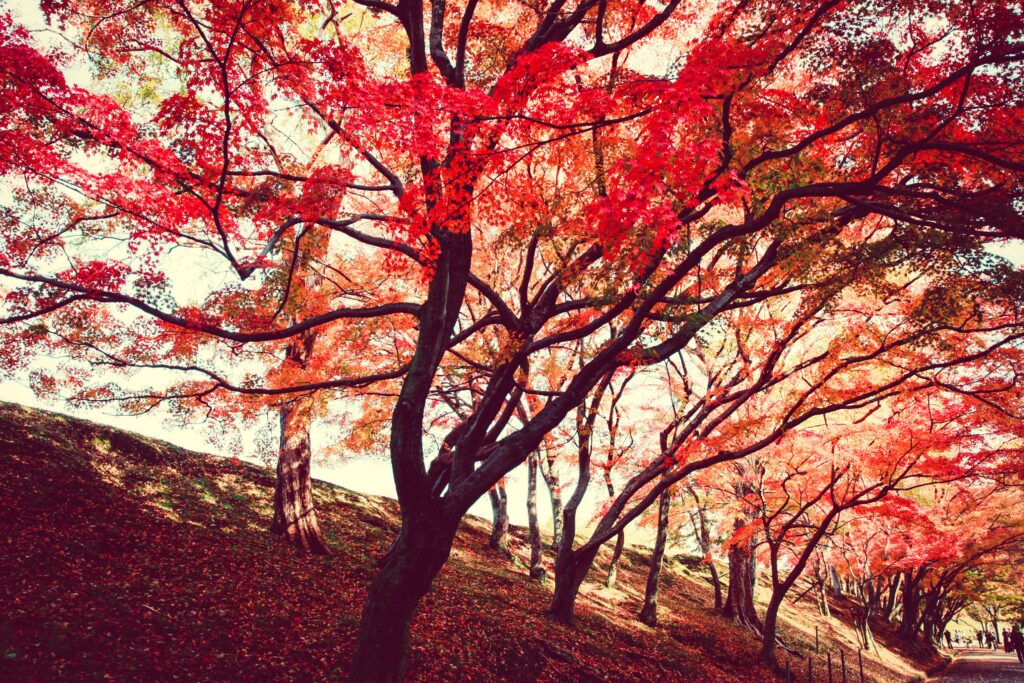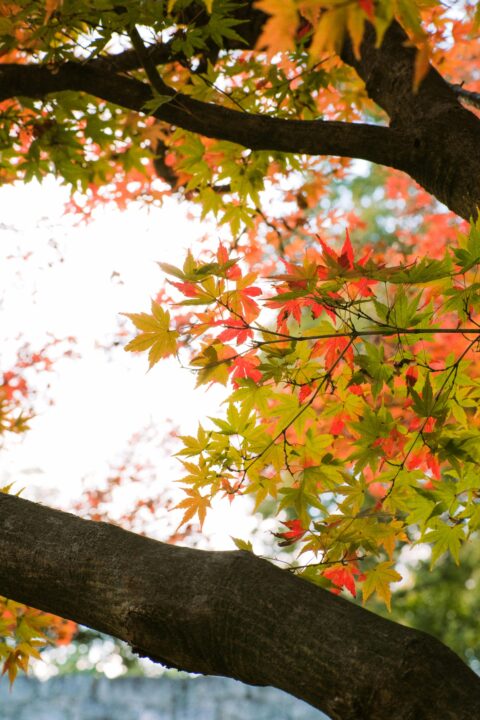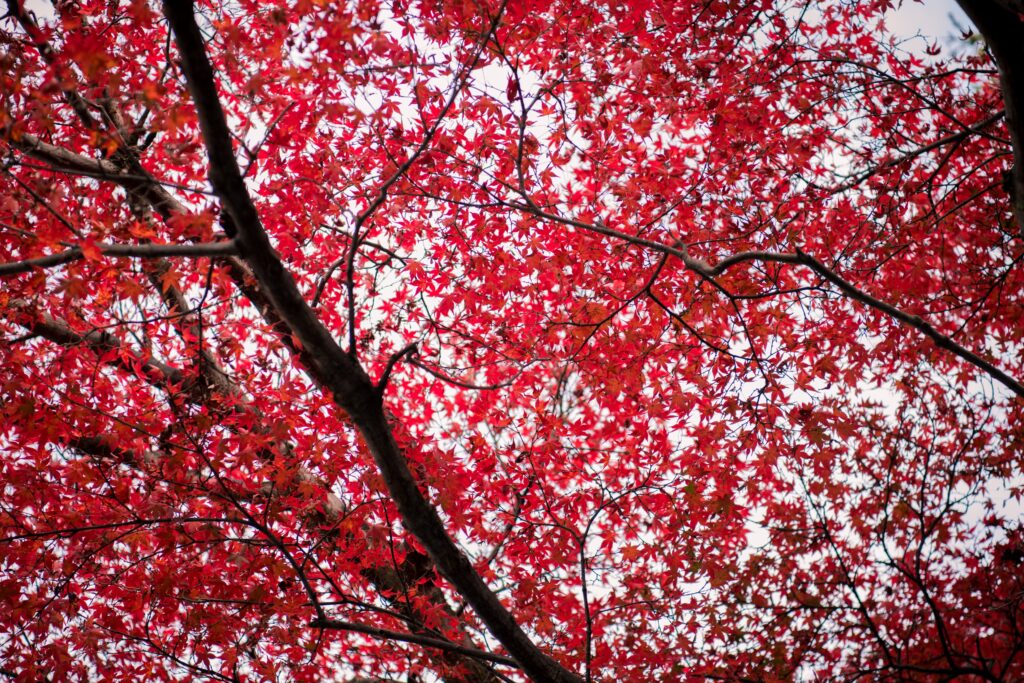Bark is a type of tissue that grows over a tree’s wood. It has an inner layer made up of living tissue and an exterior layer made up of dead tissue. The bark of trees serves as a barrier, a means of transporting nutrients throughout the tree, and a repository for waste products.
Tree bark has numerous distinctive properties and characteristics, just like flowers and leaves, and can be used to help identify a tree’s species.
Trees with Gray Bark
1. American Beech (Fagus Grandifolia)
Bark: Silvery gray
The North American beech, or American beech, is a species of beech tree that is indigenous to southeastern Canada, isolated regions of Mexico, and the eastern United States. It is a sizable, graceful native tree that thrives in expansive, park-like settings where it has the opportunity to spread its wide, slow-growing branch.
The massive trunk has beautiful silver-gray bark; the dark green summer foliage turns golden bronze in the fall. This giant tree will gradually develop to a height and spread of at least 50 feet, and those cultivated in forests will grow to a height of up to 120 feet.
The tree’s beautiful, glossy green leaves and naturally low branches cast a warm, inviting shade. But the beech tree’s deep shade inhibits the growth of many plants, so if its low branches are left uncut, no ground cover or grass is required.
The color of the leaves changes in the autumn to bronze, and some of them hang on into the winter if the wind doesn’t blow them away. On older specimens, the thin, smooth, silvery-gray bark resembles elephant skin and is highly attractive.
The leaves, bark, and buds of the beech tree are thought to be used to manufacture medication for joint pain, kidney stones, bladder stones, urinary tract infections, and other diseases, yet there is not enough scientific proof to back up this claim.
The tree’s grayish-white wood is commonly used to make toys, kitchenware, furniture, cutting boards, tool handles, charcoal, and even barrels for aging beer. The tree was used to create water wheels in colonial times because it is highly resistant to deterioration in water.
2. Sugar Maple (Acer saccharum)
-

mak jp, pexels, 10635403.jpg
Bark: smooth gray when young, gray flaky back when mature.
The sugar maple, or Acer saccharum, with a smooth, gray bark when young and irregularly ridged to flaky bark when mature, is a type of flowering plant that belongs to the Sapindaceae family of soap berries and lychee. It is well known for being the main source of maple syrup and for its vividly colored fall foliage.
Eastern Canada and the eastern United States have hardwood forests where it is indigenous. The most prevalent maple in the East is the hard-wooded, moderate-to-slowly growing sugar maple, which, when fully grown, reaches a height of 60 to 80 feet in landscape plantings.
The sugar maple grows in most soils at a rate of around one foot per year, although it is susceptible to dehydration and reflected heat, which causes the leaves to burn (become brown) along the edges.
Leaf burn from dry soil is typically seen in conditions like street tree planting, where the root system is restricted to a narrow soil area, whereas it is more drought-tolerant in areas where the roots can extend out into a vast soil expanse. Squirrels mostly like the fruits of the Sugar Maple tree, which is used by many bird species for food, nesting, and cover.
White sugar maple tree produces one gallon of maple syrup from about 40 gallons of sap. The Iroquois used maple sap as a cough remedy, an infusion of the inner bark’s compound for blindness, and drops of it for sore eyes. As a blood tonic, diuretic, and expectorant, tea made from the inner bark is also useful.
3. White Ash ( Fraxinus americana)
Bark: Light gray when young, light to dark gray when mature
The white ash, sometimes known as the American ash, is a type of ash tree that is indigenous to eastern and central North America. Native to mesophytic hardwood forests, the species is found from Nova Scotia to Minnesota in the west, to northern Florida in the south and to eastern Texas in the southwest.
Despite being a native of damp environments like river bottoms and well-drained upland areas, the white ash tree is heat resistant. At intervals of two to three years, the trees produce a large number of seeds, which then germinate in the surroundings, causing a nuisance as well as an unappealing appearance.
The white ash was used by the Native Americans for a variety of treatments, which include a brew of the leaves as a laxative and general potion for women after childbirth; the seeds were used as an aphrodisiac, as water pills, as an appetite booster; and as a fever-relieving remedy.
The bark was also used as a tea for itchy scalps, lice, snakebites, and other sores. When the tree is young, it almost has a conical shape and grows quickly, reaching heights and widths of 50 to 80 feet, but as it matures, however, it grows more slowly and takes on a wider, circular, or oval form.
White Ash, with its smooth, light gray bark when young and consistent patterns of connecting ridges forming diamond patterns from light to dark gray when mature, enjoys sunny exposure where it generates a dazzling golden autumn color and depending on the tree and the surrounding conditions, the autumn color can be compelling or boring.
4. Northern Red Oak (Quercus rubra)
-

satoshi hirayama, pexels, 1672581.jpg
Bark: Grayish brown with long gray vertical lines
The northern red oak, or Quercus rubra, belongs to the red oak family (Quercus section Lobatae). It is indigenous to eastern and central North America, as well as southeast and south-central Canada. However, it has been brought to a few minor regions of Western Europe, where it is regularly grown in parks and gardens.
The red oak, with its grayish-brown bark, has a quick growth rate and is a versatile, frequently planted oak. It is native to lush forest environments where it grows to a height of 90 feet, with a spread of 40 to 60 feet and a height of 60 to 70 feet when open-grown.
Open-grown trees have a rounded canopy that makes a wonderful shade, park, or street tree, marked by long, light-gray vertical lines that some individuals have compared to ski trails on the branches and top trunk, and in the autumn, the foliage turns a beautiful dark red.
Where overhead space is not an issue, many cities use red oak for sidewalk trees, furniture, construction timbers, finished flooring in residences, commercial buildings, and other purposes. The Ancients were well aware of the medical properties of the Northern Red Oak; the outer and inner bark are powerfully antibacterial, astringent, and fever-reducing, and they may also be used for tanning and dyeing.
5. American Basswood (Tilia americana)
Bark: Pale smooth gray when young, Grayish brown when mature
The linden tree species known as basswood, or Tilia americana, is a member of the hibiscus or mallow family (Malvaceae), commonly known as the American linden, white wood, or American basswood. Basswood is primarily found in the Great Lakes region of eastern and southeastern North America.
American linden or basswood can grow as tall as 80 to 100 feet or more, but it is most frequently seen around 40 to 50 feet with a spread of 35 to 40 feet.
When young, the tree has a pyramidal shape and a pale, smooth gray bark. Still, as it grows, mature gray-brown bark with flat ridges emerges, becoming an impressive specimen, with the lower branches still attached to the tree and slowly bending upwards before softly draping towards the ground.
The heart-shaped, four- to eight-inch-long leaves remain dark green all year and only become pale green or yellow before falling off in the autumn. The trees produce an abundance of two to three-inch-wide bunches of pale-yellow blossoms in June that are highly appealing to bees, who use them to generate a peculiar and delectable kind of honey.
Among other things, basswood, in all of its forms, is used to treat a variety of diseases and disorders. The bark is used to make a tea that is believed to treat headaches, colds, and heartburn.
Basswood is still prized today for its delicate, lightweight, and workable wood, which makes it ideal for carving, beehives, furniture, and wood fibers. Native Americans and early immigrants used the inner bark’s fiber to make rope, matting, fishnets, and baskets, in addition to using it as a large shade tree.
6. Pignut Hickory (Carya glabra)
Bark, Gray, and Scally
Pignut Hickory is a genus of roughly 18 species of deciduous wood and nut-producing trees in the walnut family. The hickory genus includes about 15 native species that can be found in Western North America, Greenland, Iceland, and Europe. These are also native to North America and eastern Asia.
The pignut hickory, which has a gray and scally bark with intersecting ridges, typically grows to a height of 50 to 65 feet and a spread of 30 to 40 feet, but it has been known to slowly grow to 120 feet in the forest.
This perennial tree is useful as a shade tree because its 8- to 12-inch-long leaves provide a coarse, oval canopy, and the robust, unevenly spaced branches resist breaking during storms. The inner bark of hickory trees is used as an astringent and a detergent, as well as dressings for injuries and ruptured or severed blood vessels. The steeped bark is drunk to make the limbs flexible.
Hickory has a wide variety of craft applications as well, including blowgun darts, arrow shafts, tool handles, firewood, barrel hoops, and corn beaters, as well as inner bark for chair bottoms, basket finishing, sporting goods, and smoking meat and fish.
Its hard inner bark and root bark were once utilized for cordage and lacing, and it also makes a fantastic wood for bow construction. It may be better to place the tree away from streets, parking lots, and other areas where automobiles frequently park since fruits might damage cars when they fall from the tree, and individuals could roll on the fruit and get unbalanced.
7. Norway Maple (Acer platanoides)
-

mushtaq hussain, pexels, 7834558.jpg
Bark; Gray and Shaggy
The huge genus of trees known as Norway Maple (Acer Plantanoides) has over 200 species. It is mainly found in China but is widely grown throughout the North Temperate Zone.
A Norway maple can grow to a height of 40 to 50 feet when in cultivation but when obscured from direct sunlight, it can grow much taller. In the spring, the rounded crown is covered in greenish-yellow blossoms. As a result of their shallow root system and thick canopy, Norway maples compete with lawn grasses, making it difficult to mow under them.
The lack of roots makes it important to plant this maple tree four to six feet away from sidewalks so the roots don’t displace them. This tree, with its dark gray bark and intersecting ridges, is one of the most significant families of decorative trees for planting on lawns, along roadways, and in parks.
It has a wide range of forms, sizes, and foliage and offers valuable hard wood for furniture and other uses. Rose-colored dye is also obtained from the bark. The Norway Maple thrives in wide varieties of soil types, including alkaline, grows swiftly, and is simple to transplant.
It stands up to coastal conditions and has a dazzling golden autumn color that is unmatched by most other trees.
8. Hop-hornbeam, Ironwood (Ostrya carpinifolia)
Bark: Shaggy Grayish Brown
The name Hop-hornbeam was coined from the fruit itself, with its clusters resembling hops. This genus is made up of about seven species of deciduous ornamental trees of the birch family (Betulaceae), which are native to Eurasia and North America.
They are also known as ironwood for their hard, heavy wood that is used locally for fence posts and small items like tool handles. The ironwood tree, as its name suggests, is a close relative of the hornbeam of the genus Carpinus and has the hardest and densest wood of any species in Canada, which can provide good firewood but is very challenging to split.
Ironwood trees are relatively short-lived and rarely grow taller than 12 meters. They can be recognized by their narrow, shaggy, grayish-brown bark. White-tailed deer, other small mammals, and birds eat the twigs, catkins, and seeds of the ironwood. Astringent, hemostatic, and blood tonic are all claimed properties of the bark. A heartwood infusion has been used to treat lung hemorrhages, coughs and colds, catarrh, and kidney issues.
An herbal concoction of the bark is used to massage muscles that are sore; a solution of the bark can be kept in the mouth to ease toothache discomfort; and a brew of the heartwood has been used to treat lung hemorrhages, coughs and colds, catarrh, and kidney issues. In addition, it is utilized as a rheumatism herbal steam bath.
Conclusion
Although tree barks are typically thought of as a muted gray color, they can contain a variety of chemical compounds that reflect and absorb different wavelengths of light, creating a broad spectrum of colors. Thus, it is always advisable to speak with a doctor before utilizing any plant as medicine.







